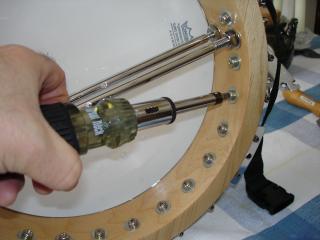
When I first took the banjo apart, here is what I found:
I guess the wood shrank a bit as it aged because every bit of hardware on it was loose! I know from previous experience with my Reiter that a banjo with a loose screw can develop some strange noises. So I tightened everything up.
I just took a Phillips head screwdriver to the shoe bolts:

It was kind of tight getting that long screwdriver in there. I must have a stubby somewhere that would work better. I checked all the bracket nuts to make sure that they had even tension.
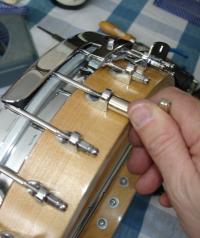
I tightened the nuts that hold on the tuners. These nuts were so loose when I took away the string tension that they were rattling around on the stems. That can cause strange buzzing sounds when the banjo is played.
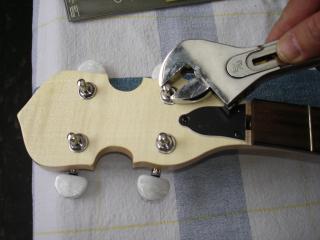
I also put some graphite into the slots on the nut. Some of the strings have been jumping when I tune them. As I slowly turned the tuning post, the string pitch would not change. Then suddenly the string would go "snap" and change its pitch. That is caused by the string binding in the nut slot. So I added some graphite from a pencil to lubricate the slots. I scraped the graphite off the point of a pencil using my penknife. Here is a photo.
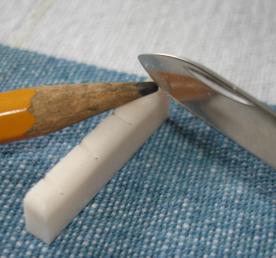
Finally I put the new strings on. Here is a photo of the method I use to figure how much slack to leave in the string when feeding it through the tuner post. I put my hand on the joint between the neck and the pot, and then I drape the string over my fingers. I feed the string through the hole in the tuning post and pull it tight with the string running over my hand. That leaves just enough slack in the string to get a good few winds onto the post. After figuring the length, I just pull the string tight in the post and lock it in the normal way. Then I turn the knob until the string is up to pitch, keeping tension on the string. I have found that it is easier to keep tension on the string by pulling it sideways against the tuning post rather than trying to grip it with my fingers and pulling on it. You just have to make sure that you don't get it tangled in the other strings and posts.
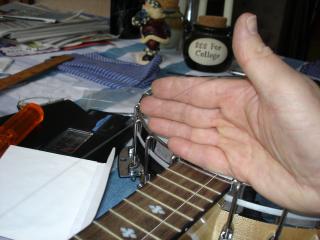
Here is the banjo all strung up with my Moon bridge on it. Is it just me, or does everybody make a mess like this while restringing their banjo? Oh well, I had it all cleaned up before my wife got home and found it.
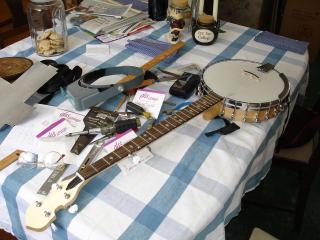
Finally, I put the resonator back on and tried it out. Here is a photo of the finished banjo. It doesn't look any different from my previous photos except for the Moon bridge, but it plays better now.
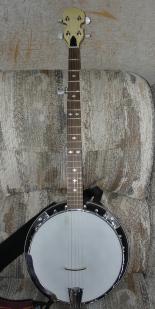
That's it. I measured the action at the 12th fret, and it appears to be about 5/32 of an inch. That is 1/32 of an inch higher than I had calculated it would be. I am not sure where the calculations went wrong. Perhaps there is some relief in the neck. I will have to check that out. Maybe it was actually higher than 3/16 when I started. Anyway, the action is lower now, and with the lighter strings, the tension on them is less when they are tuned to pitch. That makes it easier to fret them as well. It plays really nicely now, and the Moon bridge compensates the intonation of the strings very well. This is feeling like a winner.
The strings I put on are GHS J.D. Crowe light gauge strings. Their gauges are:
These are nice, easy to play strings, but the 4th string is wrapped in steel, which makes it a bit scratchy and harsh. It has a somewhat throaty, buzzy sound to it. I have the same set of strings on my Goodtime banjo, and the 4th string has the same effect on that one.
Looking at that photo again, I really do dislike the look of guitar tuners on my banjo. I makes it look a bit comical, like a kid with taxi door ears. The Goldtone guitar tuners work great, but I still think that I would like the look of the banjo better if it had real planetary pegs.
Check back here. I may be doing another upgrade soon to replace those tuners.